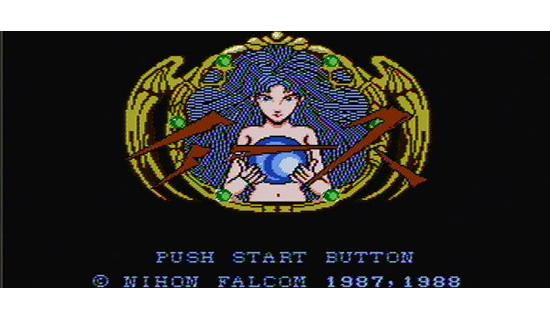Nihon Falcom’s Ys series is known as a sprawling epic of games, spanning across many different consoles and computer systems. Back in the summer of 1988 though, the first game in the series had only been released on various Japanese home computers (though it originated on the NEC PC-8801) within the last year. The second game in the series had even already hit the PC-8801 just a couple of months prior. Nihon Falcom began life as a computer game developer, and wasn’t very interested in porting their games to home consoles themselves. When one of their titles did make it outside of the home computer world, it was nearly always ported and published by other companies and with little involvement from Falcom themselves. It took Victor Entertainment, music company gone game publisher, and ghost-developer Advance Communication Company to bring us the very first home console port of Ys 1. And it’s a very interesting foot note in the history of the Ys franchise for many reasons.
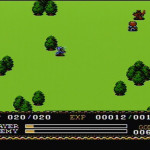 | 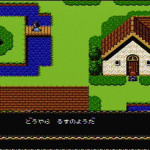 |
| This is the correct positioning to attack an enemy from, learn it well! | A lot of houses throughout both of the game’s towns will just tell you “Looks like no one’s home”. Why is the house even there? |
It’s first worth briefly mentioning some things about the first Ys game in general, a lot of which apply to the entire franchise. Each game in the series features Adol Christin, our hero, visiting new lands throughout his continuing adventures. This first game begins with Adol in Esteria, where through resolving the problems of the locals he learns about the ancient land of Ys (which will serve as the setting for the second game). The early games in this series feature a unique combat system even for an action RPG: You attack enemies by running into them. Yes, Adol does carry a sword. No, you cannot hit a button to attack an enemy with it. Combat is performed exclusively using the directional pad to move Adol into an enemy. While this may sound a bit ridiculous, it probably also sounds very easy. But be warned, it’s not quite as easy as it sounds! If you run head on into an enemy, you’ll find yourself dead very quickly! The real trick is to attack an enemy in one of three ways to avoid taking damage: From the side, from the back, or slightly offset from the front (see the screenshot above for an example). Once you get the hang of how to attack properly, the game’s challenge level goes down drastically.
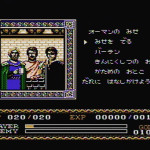 | 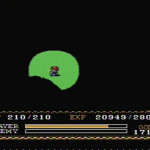 |
| The usual group down at the local bar | This is how you have to get through the entirety of the second dungeon! |
No matter which port of Ys you play, it’s a very short for an RPG. Its length is created mostly by making the player backtrack several times throughout the two towns (though one barely even counts as a town in terms of size) and three dungeons, and by certain elements that the last two dungeons use to create a high level of difficulty and frustration. There are not a lot of bosses to fight, nor does one need to spend an excessive amount of time grinding for levels or gold (it tends to happen naturally as you’re trying to find your way through dungeons or traversing the over world). Sadly this was a typical method to use at the time for artificially increasing the length and difficulty of RPGs, but Ys is hardly the worst offender. That doesn’t make traveling through labyrinthine caves with only a small spot of torchlight around your character, or navigating through a complex series of mirrors to reach specific points in Darm Tower (the final dungeon) any more tolerable when you’re actually playing the game (though different ports would handle it differently, making it degrees more or less tolerable). The one saving grace in these situations is the ability to save at nearly any time and in any location (boss rooms are the notable exception to this, and that’s hardly a big deal). It’s so rare that a game from this time doesn’t place some type of restriction on the locations at which you can save, that it’s almost like playing on an emulator with save states. I’m not certain if the other ports of Ys include this feature, but the Famicom version certainly does.
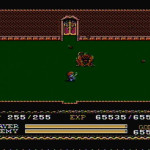 | 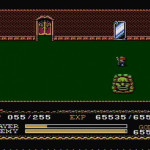 |
| Ifrit is such a bad ass in some of the Final Fantasy games, but here he just sort of jumps around and lazily shoots out fireballs | The Mask of Evil, which looks like someone’s attempt at black face? |
That being said, the Famicom port is not considered to be of very high quality when compared to all of the other Ys ports. The world map layout, dungeon layouts, Adol’s movement speed (he was made slower), the damage Adol takes when hitting a monster head-on (it was upped), boss difficulty (they were almost always made harder, save for the last boss who was made ridiculously easier) and various other related things were changed significantly from the original PC-8801 version. It’s suspected that it was due to hardware limitations of the Famicom, but no one really seems to know the reasons for sure. Though the dungeon layouts and boss difficulties were incredibly frustrating at times, almost equally as frustrating was the fact that the screen doesn’t scroll with character movement as quickly as it should. Adol’s sprite is nearly on the edge of the screen before any sort of scrolling kicks in, so the player has to be extremely quick to react to new enemies appearing. These things are the reasons why this has been ridiculed in Japan as a “novelty” version of Ys.
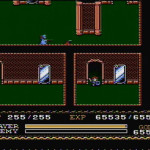 | 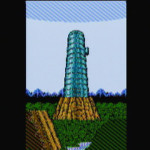 |
| The reflective hell that is the mirror rooms of Darm Tower! | A lovely shot of Darm Tower from the outside |
This port did have a few good points though. A couple of new pieces of music were used in scenarios that weren’t previously in the PC-8801 version (such as fighting the second version of Dark Fact). I’m not sure if these pieces were originally composed by Yuzo Koshiro (yes he was responsible for a large portion of the music in the first 2 Ys titles) or not. Either way, the Famicom re-programming of the original music was fairly well done. Though the overall sound quality may not be there, the good quality composition of the music itself still manages to shine through. Dark Fact was also given a second boss fight after what would in all other versions be the final boss fight, but this time he’s only referred to as “Fact”. I suppose some might consider the higher level of challenge that the differences have brought on to be a good thing, though I don’t think very many do.
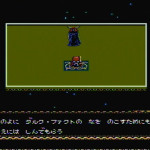 | 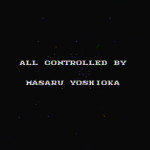 |
| Dark Fact, the best evil mastermind ever to be named from a Japanese to English dictionary | Masaru Yoshioka, The Controller of All |
While fun at first, the changes made to the Famicom port of Ys ended up being the things that frustrated me most. I can recommend playing Ys to anyone who might enjoy a good action RPG, but that’s more from the perspective of imagining what a better console port would be like. Ys did allow me to see its obvious influence on later action RPGs and how it has developed into such a beloved series, even through its Famicom ported trappings.
